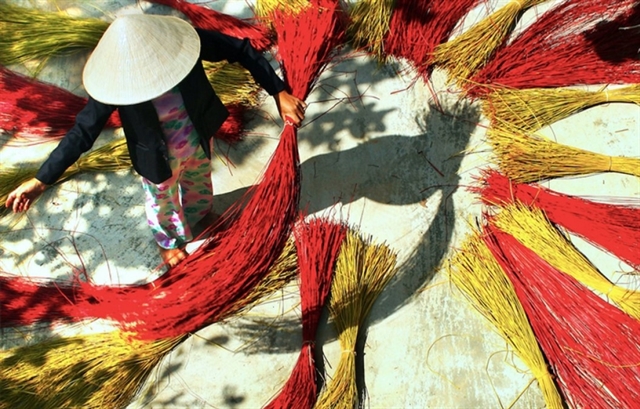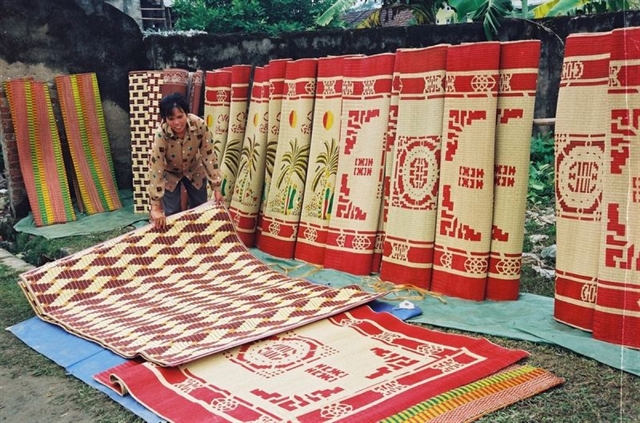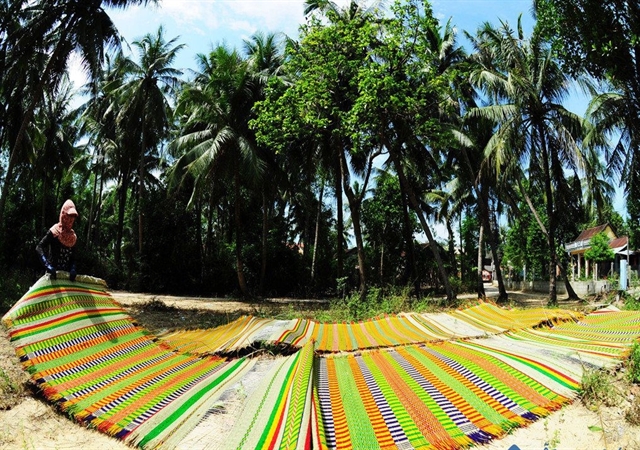 Sunday/Weekend
Sunday/Weekend

 |
| The main raw materials used to make mats are sedge stems and jute threads. — Photo courtesy of Thái Bình Province’s Department of Culture, Sports and Tourism |
By An Chi
For a long time, the sedge mats of Hới Village in Tân Lễ Commune, Hưng Hà District in Thái Bình have been a typical product of the Red River Delta province.
Nowadays, the mats, crafted from natural materials and mainly used as bed covers, are still popular, despite having to compete with many other brands. However, with improved handlooms, better sedge processing and unique techniques, weavers of Hới Village have created famous artisanal mats you simply cannot get anywhere else.
Travelling more than 40km from Thái Bình City, through many small roads and ripe rice fields, we arrived at Hới Village.
According to the village elders, the craft began in the 10th to 11th centuries, with the trade developing most strongly in the 15th to 18th centuries.
Back then, a man named Phạm Đôn Lễ, was sent as an envoy to China where he learned Chinese mat weaving techniques and then returned to teach the villagers. Ever since, the mats of Hới Village have become more beautiful and durable.
Later, the villagers worshipped Lễ as the master of mat weaving, and even built a temple to remember and honour his craftmanship.
Over time, Hới Village has become the cradle of mat making in the region.
The main raw materials used to make mats are sedge and jute threads, two types of plants commonly grown in areas near rivers, where a lot of alluvium accumulates. Conveniently, Hới Village is located between two large rivers, the Red River and the Luộc River, so the region is highly suitable for growing such plants.
The plants are harvested and undergo many meticulous stages to meet the standards required to make the iconic mats.
 |
| Mats of Hới Village are very beautiful and durable. — Photo courtesy of Thái Bình Province’s Department of Culture, Sports and Tourism |
Depending on the type of mat to be woven, the sedge stems and jute threads are dyed according to each product's need. To be able to make a satisfactory mat takes a skilful hand, rich experience and creative techniques on the part of the weaver.
There are many types of mats, some of which are flower patterned, others plain. Some are twine. The makers often decorate the mats floral patterns, landscapes or folk drawings.
The village has about 3,200 households, of which 80 per cent work in mat weaving. Each year it provides the market with millions of mats with different designs and decorative patterns.
Normally, a household weaves mats for about eight months and spends the rest of the time working in the fields.
According to villager Hà Thị Hương, the Hới mat is very beautiful and durable. Hand-made mats are more elaborate. However, productivity is low, so many people have switched to using weaving machines for higher productivity, and the workers' income has increased significantly.
“Weaving mats manually requires the craftspersons to spend a lot of effort and time. They seem to put their whole heart into each sedge stem, each weaving movement. One day one person can only weave one or two pieces. The sedge must be carefully polished, and the mats will be white and shiny. Many consumers still prefer handmade mats,” Hương said.
 |
| Hới mats are familiar products of the people in Thái Bình Province and beyond — Photo gotrangtri.vn |
Many people once feared that handmade mats of Hới Village would disappear, but they are still here and increasingly asserting the brand at a time when people want artisanal products.
The sedge mats are sold to all provinces in the country, and production has become ever more professional. Many businesses were established specialising in purchasing raw materials and selling finished products.
Many local market days specially in trading sedge mats are opened every month and are invariably busy. Merchants gather their goods from the markets and bring them across the country. VNS




